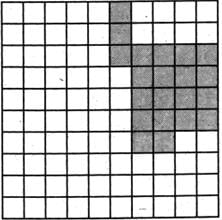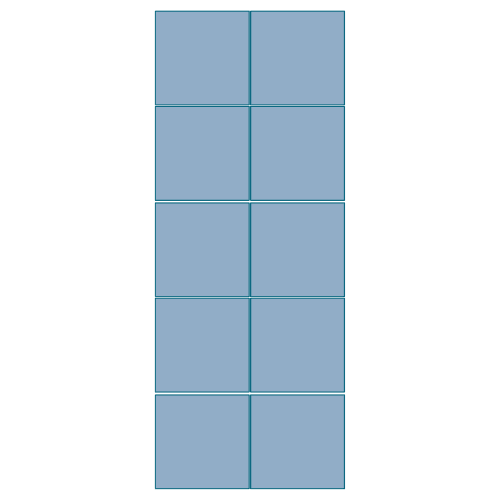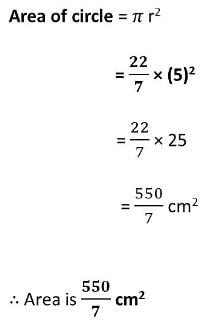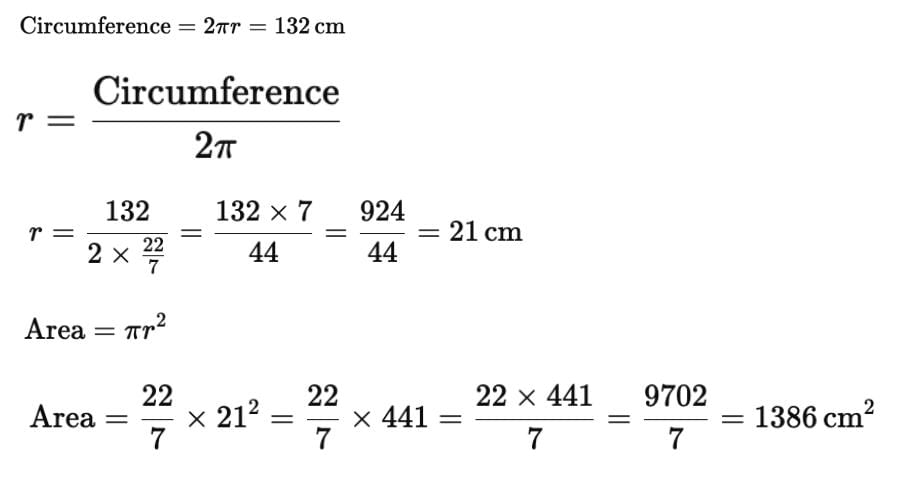All Exams >
Class 10 >
Mathematics for GCSE/IGCSE >
All Questions
All questions of Area & Perimeter for Class 10 Exam
The base in the area of parallelogram is- a)area / height
- b)area × base
- c)area / base
- d)area × height
Correct answer is option 'A'. Can you explain this answer?
The base in the area of parallelogram is
a)
area / height
b)
area × base
c)
area / base
d)
area × height
|
|
Ananya Das answered |
Since area of parallelogram is base × height
So to find Base of parallelogram the formula is = Area of parallelogram / Height
So option A is the correct answer.
The height in the area of parallelogram is- a)area / base
- b)area / height
- c)area × base
- d)area × height
Correct answer is option 'A'. Can you explain this answer?
The height in the area of parallelogram is
a)
area / base
b)
area / height
c)
area × base
d)
area × height
|
|
Avantika Desai answered |
Since Area of parallelogram is base × height
So Height = Area of parallelogram / Base
So option A is the correct answer.
What is the circumference of a circle of diameter 10 cm?- a)35 cm
- b)30 cm
- c)31.4 cm
- d)None of these
Correct answer is option 'C'. Can you explain this answer?
What is the circumference of a circle of diameter 10 cm?
a)
35 cm
b)
30 cm
c)
31.4 cm
d)
None of these

|
Tutorpedia Coaching answered |
The formula for the circumference of a circle is:
Circumference = π × diameter
Circumference = 3.14 ×10 = 31.4cm
The third side of the triangle if the perimeter of a triangle is 20m and two of its sides are 5m and 4m, is- a)11 m
- b)10m
- c)12m
- d)5m
Correct answer is option 'A'. Can you explain this answer?
The third side of the triangle if the perimeter of a triangle is 20m and two of its sides are 5m and 4m, is
a)
11 m
b)
10m
c)
12m
d)
5m
|
|
Aditi Sharma answered |
Perimeter of a triangle =1stside+2ndside+3rd side So, 20=5+4+3rdside 3rdside=20−9=11m.
What is the area of rectangle if Length = 2m, Breadth = 5m- a)12m2
- b)14m2
- c)10m2
- d)18m2
Correct answer is option 'C'. Can you explain this answer?
What is the area of rectangle if Length = 2m, Breadth = 5m
a)
12m2
b)
14m2
c)
10m2
d)
18m2
|
|
Aditi Sharma answered |
The area of rectangle is given by length × breadth. So the area is 2 × 5 = 10m2.
Area of rectangle is 32m2. If the length is 8m then breadth = ________
- a)20m
- b)4m
- c)10m
- d)12m
Correct answer is option 'B'. Can you explain this answer?
Area of rectangle is 32m2. If the length is 8m then breadth = ________
a)
20m
b)
4m
c)
10m
d)
12m
|
|
Aditi Sharma answered |
Given, area = length × breadth
⇒ breadth = area÷length
So, the breadth = 32/8 = 4m.
⇒ breadth = area÷length
So, the breadth = 32/8 = 4m.
Find the area of shaded region. (Each square = 1m2)

- a)21m2
- b)35m2
- c)34m2
- d)13m2
Correct answer is option 'A'. Can you explain this answer?
Find the area of shaded region. (Each square = 1m2)


a)
21m2
b)
35m2
c)
34m2
d)
13m2

|
Nipuns Institute answered |
- Calculate no. of shaded boxes.
- It comes out to be 21.
- And each box has area of 1m2.
- So the area of shaded region = 21m2.
Find the perimeter of a triangle with sides 4 cm, 6 cm and 10 cm
- a)20cm
- b)24cm
- c)9cm
- d)18cm
Correct answer is option 'A'. Can you explain this answer?
Find the perimeter of a triangle with sides 4 cm, 6 cm and 10 cm
a)
20cm
b)
24cm
c)
9cm
d)
18cm

|
Jaya Mukherjee answered |
Perimeter = Sum of all the sides
Perimeter of a triangle = a+b+c
Here a = 4cm , b = 6cm , c =10cm
(6+4+5)cm=15cm
So option A is the correct answer.
The amount of surface in a closed plane figure is called _______- a)Area
- b)Perimeter
- c)Volume
- d)None of the above
Correct answer is option 'A'. Can you explain this answer?
The amount of surface in a closed plane figure is called _______
a)
Area
b)
Perimeter
c)
Volume
d)
None of the above
|
|
Jay Rane answered |
The Concept of Area
The term "area" refers to the amount of surface enclosed within a closed plane figure. It is a fundamental concept in geometry, particularly relevant for various shapes like squares, rectangles, triangles, and circles.
Understanding Area
- Definition: Area is the measure of the space inside a shape. It quantifies the extent of a two-dimensional figure.
- Units of Measurement: Area is typically measured in square units (e.g., square meters, square centimeters). This indicates how many unit squares can fit within the figure.
- Applications: Knowing the area helps in practical situations, such as determining how much paint is needed to cover a wall or how much land is available for farming.
Comparison with Other Terms
- Perimeter: This is the total distance around the boundary of a figure. While area focuses on space within the shape, perimeter deals with the outline.
- Volume: Volume pertains to three-dimensional objects and measures the space occupied inside them. It is distinct from area, which strictly applies to two-dimensional figures.
Conclusion
Hence, the correct answer to the question is option 'A', Area, as it accurately describes the amount of surface within a closed plane figure. Understanding this concept is crucial for students in mathematics, as it lays the foundation for more complex topics in geometry and real-world applications.
The term "area" refers to the amount of surface enclosed within a closed plane figure. It is a fundamental concept in geometry, particularly relevant for various shapes like squares, rectangles, triangles, and circles.
Understanding Area
- Definition: Area is the measure of the space inside a shape. It quantifies the extent of a two-dimensional figure.
- Units of Measurement: Area is typically measured in square units (e.g., square meters, square centimeters). This indicates how many unit squares can fit within the figure.
- Applications: Knowing the area helps in practical situations, such as determining how much paint is needed to cover a wall or how much land is available for farming.
Comparison with Other Terms
- Perimeter: This is the total distance around the boundary of a figure. While area focuses on space within the shape, perimeter deals with the outline.
- Volume: Volume pertains to three-dimensional objects and measures the space occupied inside them. It is distinct from area, which strictly applies to two-dimensional figures.
Conclusion
Hence, the correct answer to the question is option 'A', Area, as it accurately describes the amount of surface within a closed plane figure. Understanding this concept is crucial for students in mathematics, as it lays the foundation for more complex topics in geometry and real-world applications.
A rectangle has a length of 12 cm and a breadth of 7 cm. What is its perimeter?- a)38 cm
- b)24 cm
- c)19 cm
- d)60 cm
Correct answer is option 'A'. Can you explain this answer?
A rectangle has a length of 12 cm and a breadth of 7 cm. What is its perimeter?
a)
38 cm
b)
24 cm
c)
19 cm
d)
60 cm
|
|
Yashina Kapoor answered |
The perimeter of a rectangle is calculated using the formula:
Perimeter = 2 × (Length + Breadth)
Substituting the given values:
Perimeter = 2 × (12 cm + 7 cm) = 2 × 19 cm = 38 cm
Perimeter of square = 160 cm, length of side of square = ________________- a)40cm
- b)50cm
- c)70cm
- d)20cm
Correct answer is option 'A'. Can you explain this answer?
Perimeter of square = 160 cm, length of side of square = ________________
a)
40cm
b)
50cm
c)
70cm
d)
20cm
|
|
Lakshmi Mehta answered |
Understanding the Perimeter of a Square
The perimeter of a square is calculated by adding the lengths of all four sides. Since all sides of a square are equal, the formula to find the perimeter can be expressed as:
- Perimeter (P) = 4 × Length of one side (s)
Given Information
- The perimeter of the square is provided as 160 cm.
Calculating the Length of One Side
To find the length of one side of the square, we can rearrange the formula:
- Length of one side (s) = Perimeter (P) ÷ 4
Now, substituting the given perimeter:
- Length of one side (s) = 160 cm ÷ 4
Performing the Calculation
- Length of one side (s) = 40 cm
This calculation shows that the length of each side of the square is 40 cm.
Conclusion
- Therefore, the correct answer to the question is option 'A': 40 cm.
By understanding the relationship between the perimeter and the sides of a square, we can easily solve similar problems in the future. Always remember, the key is to know the formula and how to rearrange it as needed!
The perimeter of a square is calculated by adding the lengths of all four sides. Since all sides of a square are equal, the formula to find the perimeter can be expressed as:
- Perimeter (P) = 4 × Length of one side (s)
Given Information
- The perimeter of the square is provided as 160 cm.
Calculating the Length of One Side
To find the length of one side of the square, we can rearrange the formula:
- Length of one side (s) = Perimeter (P) ÷ 4
Now, substituting the given perimeter:
- Length of one side (s) = 160 cm ÷ 4
Performing the Calculation
- Length of one side (s) = 40 cm
This calculation shows that the length of each side of the square is 40 cm.
Conclusion
- Therefore, the correct answer to the question is option 'A': 40 cm.
By understanding the relationship between the perimeter and the sides of a square, we can easily solve similar problems in the future. Always remember, the key is to know the formula and how to rearrange it as needed!
Which of the following has the formula : Base × Height- a)area of parallelogram
- b)area of square
- c)area of quadrilateral
- d)area of trapezium
Correct answer is option 'A'. Can you explain this answer?
Which of the following has the formula : Base × Height
a)
area of parallelogram
b)
area of square
c)
area of quadrilateral
d)
area of trapezium

|
Shiksha Academy answered |
- The area of a parallelogram is calculated as Base × Height.
- This formula works because the height is the perpendicular distance from the base to the opposite side.
- Unlike triangles or trapeziums which require different calculations or coefficients, a parallelogram's area is directly obtained by multiplying its base by its height.
- Thus, option 1 is the correct answer as per the provided solution.
The distance around a circular region is known as its_______.- a)Circumference
- b)Area
- c)Volume
- d)None of the above
Correct answer is option 'A'. Can you explain this answer?
The distance around a circular region is known as its_______.
a)
Circumference
b)
Area
c)
Volume
d)
None of the above

|
Praveen Kumar answered |
- The distance around a circular region is known as its circumference.
- Circumference is the term used to describe the perimeter of a circle.
- Circumference is the term used to describe the perimeter of a circle.
What will be the area of a rectangle of length 20 cm and breadth 15 cm?- a)200 cm2
- b)340 cm2
- c)300 cm2
- d)250 cm2
Correct answer is option 'C'. Can you explain this answer?
What will be the area of a rectangle of length 20 cm and breadth 15 cm?
a)
200 cm2
b)
340 cm2
c)
300 cm2
d)
250 cm2

|
Indu Gupta answered |
Area of rectangle = length x breadth
area = 20 cm x 15 cm
area = 300 cm2
Calculate the area of rectangle given below if each square has an area of 4m2.

- a)80m2
- b)64m2
- c)40m2
- d)15m2
Correct answer is option 'C'. Can you explain this answer?
Calculate the area of rectangle given below if each square has an area of 4m2.


a)
80m2
b)
64m2
c)
40m2
d)
15m2
|
|
Edu Impact answered |
- There are 2 squares in one row.
- So, there are 2×5=10 squares in total and each square has an area of 4m2
- So, the area of rectangle =2×5×4
- = 40m2.
Find the area of a triangle with a base of 10 cm and a height of 30 cm- a)150
- b)100
- c)400
- d)600
Correct answer is option 'A'. Can you explain this answer?
Find the area of a triangle with a base of 10 cm and a height of 30 cm
a)
150
b)
100
c)
400
d)
600

|
Praveen Kumar answered |
We know Area of a triangle is bxh/2
where b is base and h is height
Given that base is 10 cm and height is 30 cm
Area of a triangle 10 cm x 30 cm / 2
= 300 cm2/2
= 150 cm2
So option A is the correct answer.
Chapter doubts & questions for Area & Perimeter - Mathematics for GCSE/IGCSE 2025 is part of Class 10 exam preparation. The chapters have been prepared according to the Class 10 exam syllabus. The Chapter doubts & questions, notes, tests & MCQs are made for Class 10 2025 Exam. Find important definitions, questions, notes, meanings, examples, exercises, MCQs and online tests here.
Chapter doubts & questions of Area & Perimeter - Mathematics for GCSE/IGCSE in English & Hindi are available as part of Class 10 exam.
Download more important topics, notes, lectures and mock test series for Class 10 Exam by signing up for free.

Contact Support
Our team is online on weekdays between 10 AM - 7 PM
Typical reply within 3 hours
|
Free Exam Preparation
at your Fingertips!
Access Free Study Material - Test Series, Structured Courses, Free Videos & Study Notes and Prepare for Your Exam With Ease

 Join the 10M+ students on EduRev
Join the 10M+ students on EduRev
|

|
Create your account for free
OR
Forgot Password
OR
Signup on EduRev and stay on top of your study goals
10M+ students crushing their study goals daily
















